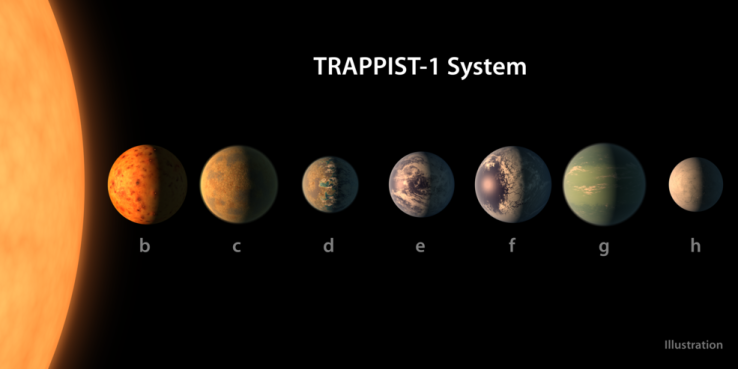NASAが「地球によく似た」系外惑星を7つ発見!たったの40光年先ですよ
NASA found 7 “Earthlike” planets just under 40 light years away
NASA has discovered seven planets with Earth-like qualities orbiting a nearby star making them among the strongest candidates in the continued search for extraterrestrial life among known exoplanets, or planets that exist outside of our own solar system.
NASAは7つの惑星を見つけました。 これらは地球のような環境を持ち、主星の周りを周っており、 系外惑星、つまり我々の太陽系外に存在する惑星において探し続けられている地球外生命が存在する最も強い候補となっています。
These new planets all inhabit another solar system which includes seven planets that have a relatively warm climate, as well as rocky terrain, both of which are promising signs in terms of identifying starting points for the search for both water and life. The planets all orbit TRAPPIST-1, a so-called ‘ultracool dwarf’ star, which unfortunately does not mean that it shares characteristics with Gimli from the Lord of the Rings.
これらの新しい惑星すべてが、7つの惑星を含む別の太陽系に属しており、比較的暖かい気候で、岩の多い地形です。 この両方が、水と生命体を探す条件のスタート地点である兆候を約束しているのです。 これら惑星はすべて、「超低温矮星」と呼ばれるTRAPPIST-1の軌道を周回しています。 残念ながらロード・オブ・ザ・リングスのGimliと、その特性を共有しているわけではありません。
Instead, the TRAPPIST-1 star is just a tenth the size of our own sun, and only gives off around a quarter of the radiant heat. The planets are far nearer the sun, too: the one closest in has a ‘year’ (the time it takes it to orbit the star) of a little over one day, and the one the furthest out completes its own annual cycle in only 20 days.
この主星、TRAPPIST-1のサイズは私達の太陽のちょうど10倍で、輻射熱はたったの4分の一しか与えてくれません。 これら惑星は太陽に非常に近く、ある最も近いものは、(地球上の)1日よりも少し長い時間の1年(主星の周りを一周する時間)を持ち、最も遠いものでも、その1年は、たったの20日間です。
The TRAPPIST-1 system and its terrestrial planets are a huge milestone because before their discovery, we were basically limited to four candidates – one of which was our own. These new Earth-sized celestial bodies were originally discovered when researchers including lead author of the new study Michaël Gillon of the University of Liège were studying the TRAPPIST-1 star they’d been observing since 2015, and noticed decreases in the star’s brightness, caused by the momentary occlusion of the star by the passage of three of the system’s planets across its surface.
このTRAPPIST-1太陽系とその岩石型惑星は大きなマイルストーンです。 なぜなら、その発見以前は、私たちは基本的に4つの候補に限られていたからです ― その1つは私達自身です。これらの地球に似たサイズの天体は、もともと 新しい研究の筆頭の著者リエージュ大学のミハエル・ギヨンを含む研究者たちが、2015年から観測していたTRAPPIST-1の研究により発見され、 その表面を3つの系内惑星が通過することで、瞬間的に星の光を遮り、その星の光度の減退を示していました。
NASA has also been very quick to temper expectations from observers who think this might signal favorable possibilities in terms of the discovery of alien life – the likelihood is slim, and it’s very early yet in terms of figuring out if the planets have other characteristics they share with Earth beyond rockiness and relative warmth owing to their placement in the so-called “habitable zone” of TRAPPIST-1 – like whether they even have atmospheres and the presence of water or other gases like oxygen.
NASAはまた、これがエイリアンの発見の好ましい可能性の信号かもしれないと考える観測者からの期待を、非常に素早く抑えてきました。 その可能性は薄く、TRAPPIST-1の「ハビタブルゾーン(居住可能域)」内に、岩石が多くて、比較的暖かであることを越えて、 これら惑星が、大気や水、他のガス、例えば酸素などが存在するかどうかといった、地球と共有する他の特性があるかどうかを指摘するにはまだ早すぎるのです。
Still, finding this many planet orbiting a star so nearby with even basic Earth-like characteristics is a promising sign, according NASA researchers. It suggests that indeed, as some have theorized, the galaxy could be littered with Earthish planets – far more than we might’ve suspected.
NASAの研究者によると、星の軌道を周回する、基本的には地球に似た特性を持つ、この多くの惑星の発見は、明らかに、ある兆候を示しています。 いくつかは理論化されているように、銀河は私達が考えている以上に地球型惑星で満たされていると言って良い。 確かにこのように示唆しているのです。
元記事は以下。
https://techcrunch.com/2017/02/22/nasa-found-7-earthlike-planets-just-under-40-light-years-away/

